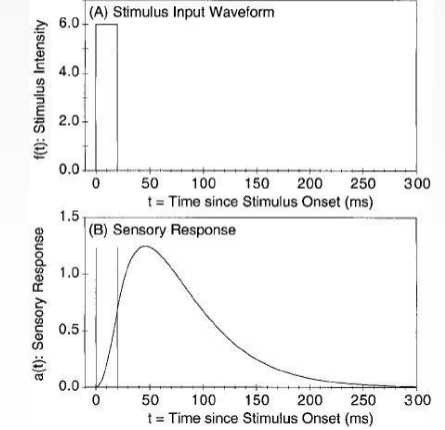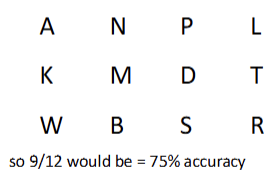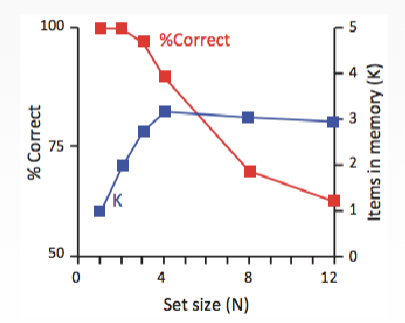L14-Iconic memory and working memory
1/14
There's no tags or description
Looks like no tags are added yet.
Name | Mastery | Learn | Test | Matching | Spaced |
|---|
No study sessions yet.
15 Terms
visual memory systems
iconic memory
persistent perceptual representations - when something disappears we still process it
visible and informational persistence
working memory
active maintenance
once gone, will fade away into smaller things
long term memory
episodes encoding and retrieval
find representation in the mind
store something in mind and taking out later
iconic memory - visible persistence
seeing a scene after t disappeared seems to be true
tells us how fast iconic memory fades away
ex// phone flash
spinning it around leaves a trail of light appears like a closed circle that we can process in other locations
when the light is on, no response from visual system
sensor increases
visual system is still being processed

studying visible persistence - missing dot demo
had participants go through two demos where they’re asked to remember where the dots were
first demo - with a delay
when participants had a delay and then were shown the grid, it was harder to detect the dots location
demo 2 - with no delay
when participants just saw the grids back-to-back, they can see the empty location when seeing both
people are very good if stimuli separated by <100ms but quickly get very bad after that (for large number of dots
more dots DOESN’T make it hard, longer delays make it hard

informational persistence and the transition to WM
Sperling believed that he can see more than he can report
limitations is not storing the info but in reporting it
iconic memory goes beyond seeing stuff
created whole report (write all the letters) and partial report (sound cues)
Sperling’s whole report demo
presented a 4×3 matrix of letters and asked participants to report all items they saw
start with fixation —> flash letters —> delay —> report
results
people couldn’t report more than about 4-5 items on each trial
100ms = 4-5 letters stay in mind

Sperling’s partial report demo
showed participants a 4×3 matric of letters and asked people to report all the items from a specific row
cued them to which row thy reported by playing a high or low pitch tone
fixation —> letters —> tone —> report (if you knew all letters report regardless of tone)
results
subjects could typically report all 4 items on each trial
knew all letters 100ms AFTER sound was played —> can get all letters in one row
effect of delay tone - multiplying backwards
varied time between disappearance of the display and the onset of the cue tone of 0 to 1 sec
Sperling’s results
with short delays, people report proportionally more but longer delays in partial report performance is similar to whole report
ex// people can account 10-12 letters after display ut only 4-5 items if there’s a longer delay

iconic memory format
visible persistence
about 200ms from the ONSET of a stimulus - response to new stimulus last 200ms
first wave of visual response continues whether stimulus remains present or not
stay onscreen and disappears = no visible persistence, disappears right away
informational persistence
about 500ms after the OFF set of a stimulus - disappears = you still know something about it
high capacity of information
very short duration (last about .5 sec)
decaying in the neural firing in the visual system after item disappears
is visible persistence the same as after image
no because different time courses. after image requires >1 sec of exposure, visible persistence arises for very short presentations (<200ms)
tested - if using afterimage then letters green and red become the opposite
results: people recall correctly with a color cue and don’t invert the colors
quick flash =cont. neuron firing of stimulus
afterimage = store for long = brain adapts

informational persistence really visual info
big partial report advantage for color cues even if cue arrives 50ms after display
no partial report advantage for digit/letter cue after the display
but digit/letter cues are helpful if they happen BEFORE the display, so not like people can’t use them at all - no partial report advantage
if display is after display is gone = no memory/processed image in their mind
activation persists for some time then slowly fades unless it’s protected
when do we need VWM
saccadic suppression
eveyr time we move our eyes the visual cortex gets a huge wave of blurred images wich we are unaware of '
eye movements mostly erase iconic memory, so as soon as we need to move our eyes around a scene to perceive everything, VWM comes into play and protects it w attention
VWM actively protecting some visual representations and hiding objects in mind. EXTREMELY LIMITED CAPACTY
VWM limits processing info in front of you - bar demo and greeble demo
when asked which bar is taller left or right we have to keep moving our eyes and form a memory task because we can’t process the L/R at the same time
greebles
when asked if both pf the greebles are different or the same we look at one object and try to store the information in mind to look at the other greeble
compared to WM actively protecting info to make a comparison
we are not integrating everything we see into one single world view
change blindness w no quick flashes
eye movements alone make it very difficult to notice changes
we only hold in mind a small subset of info across eye movements
ex// car demo
we can’t notice the change in doors or anything else only when we make a comparison w know something changes
eye movements = erase memory
VWM - typically quantified w simpler stimuli: circle demo
trying to determine how much information we can hold in mind or how many items
circle demo:
we see two different displays of colored circles
tasked to state whether or not we saw the difference
results
when we have one item = one item in mind (100% correct)
4 in mind we can still get 100 % correct
if set size gets larger, we get more incorrect
we can only hold 3-4 items in mind to protect some portion of that many objects from interference

no magical number 4 if asked to do asked that more precisley measure memory - selecting color demo
participants are flashed circles of different colors and are asked to match the color of the circle with the color wheel to the best of their ability
hard to find the exact color
big decreases in accuracy even in holding 1 thing to 3 things at a time
not like we can hold 4 things just as well as 4
if it was one circle = they were in the same range
3 circles = less precise memory because it’s harder to hold